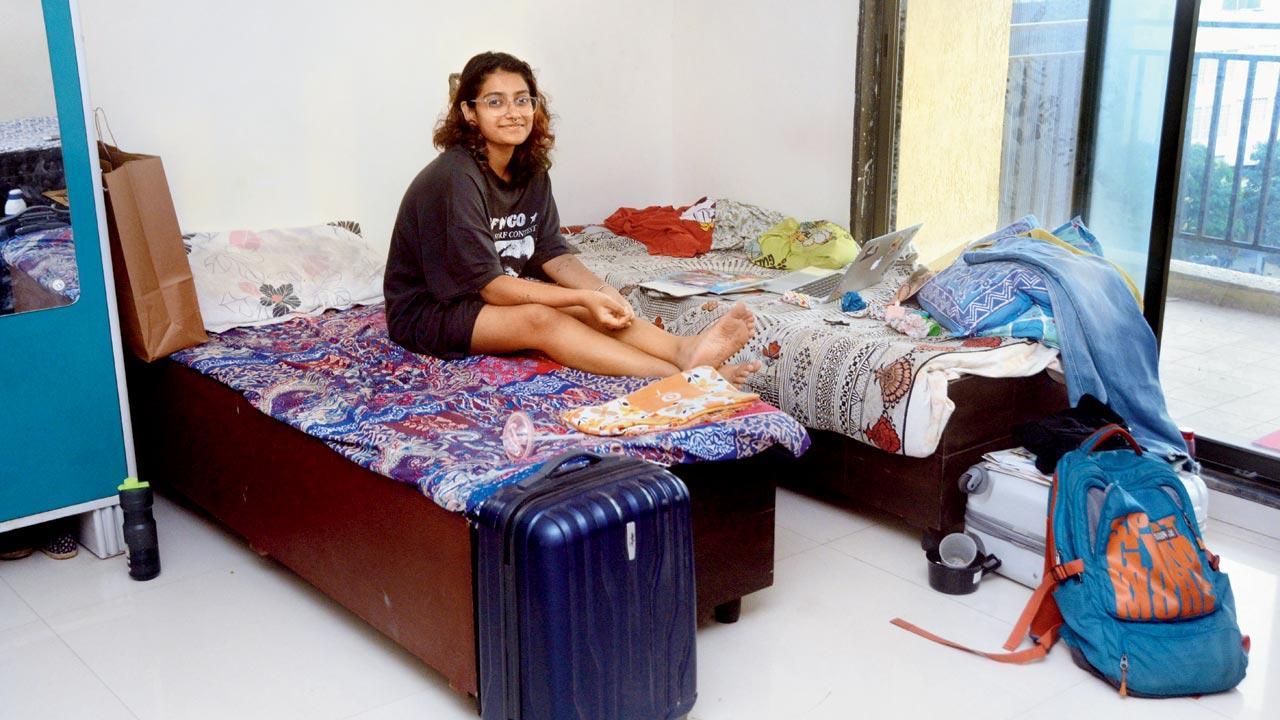With Oxford Dictionary establishing ‘Goblin Mode’ as the word of the year, we find out why some people want to live like the “ugly, lazy” creature Enid Blyton introduced to us when we were children

Chandrima Bhattacharya, a 21-year-old student doesn’t do household chores, leaves her utensils unwashed and avoids making her bed, but can’t stand a single piece of unwashed garment and immediately tosses it in the washing machine. Pic/Satej Shinde
Having shrikhand with cheese balls, mixing honey in Maggi or dipping spicy masala chips in chocolate sauce and more such “weird food choices” made Mumbai-based media student Chandrima Bhattacharya believe that she was indeed living her life in “goblin mode”. With words such as “metaverse”, “#IStandWIth”, and “goblin word” as official entries to be Oxford Dictionary’s word of the year, Goblin mode stood out with 318,956 votes.
ADVERTISEMENT
“Given the year we’ve just experienced, ‘Goblin mode’ resonates with all of us who are feeling a little overwhelmed at this point. It’s a relief to acknowledge that we’re not always the idealised, curated selves that we’re encouraged to present on our Instagram and TikTok feeds,” says Casper Grathwohl, President Oxford University Press’ (OUP) Oxford Languages in a press statement. According to the dictionary, the slang term refers to a type of behaviour which is “unapologetically self-indulgent, lazy, slovenly, or greedy, typically in a way that rejects social norms or expectations.” With the sudden outburst of reels on Instagram on terms such as ‘Cottagecore’ (an Internet trend which has pastel colours and teens celebrating an idealised English or European rural life) and ‘That Girl’ (a person who gets up at 5 am, meditates, goes to the gym, drinks smoothies, journals, has an elaborate shower and skin routine, eats healthy, doesn’t party and is successful); the goblin mode is the opposite of that. A piece in The Guardian states that, “Goblin mode is like when you wake up at 2 am and shuffle into the kitchen wearing nothing but a long T-shirt to make a weird snack.” “It’s about a complete lack of aesthetic. Because why would a goblin care what they look like? Why would a goblin care about presentation?” it further added. For the ones who only knew goblins as cute creatures of the wood that appeared in author Enid Blyton’s books, according to the famous English folklorist, Katharine Mary Briggs (1898-1980), goblins are also known as evil and ill-intentioned spirits. Small and ugly in appearance, they are embedded in the rich folklore of the United Kingdom, in particular.
 Swati Bhagchandani
Swati Bhagchandani
All it took for 29-year-old Divya Ramaswamy to get into this sort of lifestyle was revenge partying. “My pandemic was chill, but the lack of social interaction got to me eventually and as soon as restrictions eased out this year. I went wild,” says Ramaswamy, who is based in Goa. “Eventually, I was exhausted because I was juggling work, socialising and travelling and there came a point where I couldn’t take it anymore and became a recluse.” She admitted that this went on for two to three months and now it is a mix of staying like this during the week and socialising during the weekend or “people come over and we goblin mode together.” Her work-from-home job in the field of operations allows her to stay in on days at end, order food, drink and smoke, play video games, scroll through Instagram reels till 3 am, watch movies and “ignore her entire social circle.” Ramaswamy accepts that this is a very unhealthy lifestyle but for her, it is a social and stress detox from work, relationships and other problems such as finances. “I would call this going into hiding mode,” she says.
Bhattacharya, on the other hand, believes that there are many other routine things she does, that are proof of her living in goblin mode—something which she earlier referred to as being lazy. For example, if she drank her coffee in a particular mug one day, then the next day she would have fruit juice in it. But, for someone who doesn’t do many household chores, leaves her utensils unwashed and avoids making her bed as much as possible, she gets bothered when even a single piece of clothing is unwashed and laying in her room. “Many people wash their clothes together on a weekly basis and I’m not sure if it is OCD or what, but once I couldn’t even sleep at night,” she shares. “Even if it is one cloth, I need to put it in the machine. Even though it can be hand-washed, the thought of putting physical effort bothers me. I just put it in the washing machine.” The 21-year-old admits that her friends used to judge her, but she now doesn’t bother and follows the mantra of “you do you”. Her family just thinks she is “lazy”.
“The differencing factor,” says clinical psychologist, Swati Bhagchandani, “is being unapologetic about it.” People who are lazy sometimes report guilt and distress about it when pointed out, but here a person is choosing to be in this mode, she further explains. This kind of behaviour can be of concern if the person is feeling distressed and if the habit harms them and if there is any dysfunctionality,” says Bhagchandani. Bhattacharya also admitted that the only thing which will get her to change her habits and behaviour is if it’s causing any inconvenience or harm to the people around her, which currently it isn’t. The duration of this phase also matters, says Bhagchandani. “Taking a break for a specified duration is different than wishing to stay in this mode and lifestyle for an unspecified duration. The latter can be a matter of concern,” she explains. Ramaswamy, who got into this mode after the pandemic, says that she hasn’t tried to overcome this as of now. “I feel like I need several months or days of zero pressure on myself,” she states. Another aspect of concern according to Bhagchandani is a person who has made this a lifestyle mode.
Overall, Bhagchandani concludes that the picture goblin mode paints “definitely is an indication of dysfunctionality or a lack of functionality if it is an unspecified duration.”
 Subscribe today by clicking the link and stay updated with the latest news!" Click here!
Subscribe today by clicking the link and stay updated with the latest news!" Click here!







